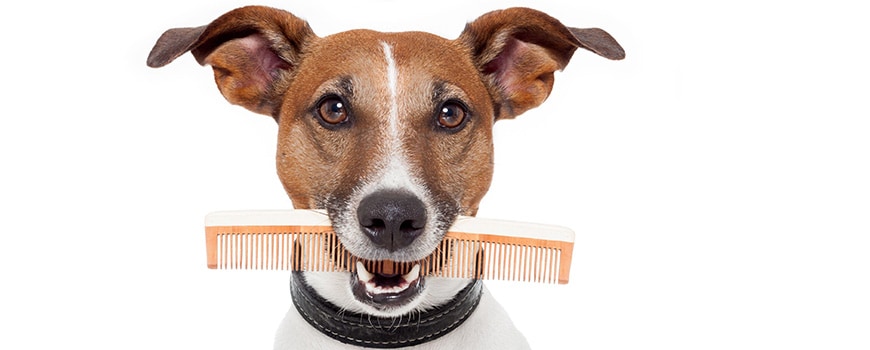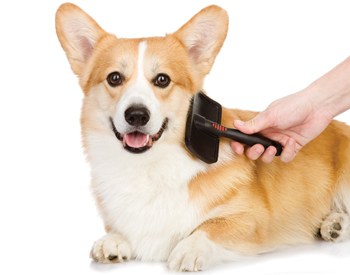The health of a dog’s coat is influenced by many factors. Genetically, a dog can inherit coat quality from its predecessors, but there are many other influences, such as diet, exercise, the dog’s housing and bedding, as well as its grooming regime. All coats can be improved with just a little effort and consideration of the dog’s individual needs.
Feeding
What you feed your dog counts. When considering feeding, it is always advisable to listen to your breeder’s advice.
Most reputable breeders have worked out a diet that suits their breed of dog and are careful to give new puppy owners a diet sheet to follow through from puppyhood to adult age. Certainly, good breeders are keen to support the new puppy owner and will provide after-sales advice throughout the dog’s lifetime.
As no two dogs are alike, it is possible for two pups from the same litter to have completely different dietary needs. Though this is unusual, as dogs are basically scavengers, some dogs will have special needs, and your breeder may be able to suggest a suitable alternative diet.
Natural Diet
We all try to do the best we can for our dogs, and this includes giving them the best food. Many of us believe that the more you spend, the better the results, which is not necessarily true.
We are what we eat, and dogs are no exception. Feeding the dog is important to skin and coat care, but it is essential to point out that the needs of every dog can differ one to another; not all dogs suit the same diet, no matter what their owners’ preferences. However, if a natural diet is fed, then there is far less likelihood of adverse reactions and the coat of the dog is a shining example of what goes inside the dog.
A diet of raw lamb and beef bones, tripe, lamb, chicken and beef with organic vegetables and two or three days a week, a meal made from brown rice and chicken is a healthy, natural diet for a dog.
Raw, natural diets need consideration to ensure a variety of vitamins and minerals. Eggs are a good source of nutrients. Live yogurt has calcium. Cheese has many essential nutrients as well as being a good source of calcium, and most dogs love cheese. Meat can be varied, as tripe, beef, chicken, turkey and lamb are all easily available in wonderful little flat, easy-store freezer packs from most pet shops. Offal can be fed once a week.
Wheat is commonly used in dog food, but many dogs are allergic to this. Rice can be used along with lentils, peas, beans and chickpeas. Vegetables can be given to a dog with a free hand. Packs of mixed vegetables from the freezer at the supermarket are ” wonderful and easy to feed, and dogs love them — just give a handful a day to large dogs and a bit less to small dogs.
Dogs love fruit. Some like bananas, some like oranges. If the dog likes it, feed it – they usually know best. Certainly, they love blackberries and apples, and their mouth waters for raw cabbage and raw broccoli. However, it is best to avoid grapes, which are toxic to dogs.
Fats such as olive oil and peanut oil are nourishing, as are fish, brewer’s yeast, kelp and dandelion. Fiber, such as oat bran, will help to prevent anal gland trouble. Cider vinegar is useful for the dog as well as us. It’s good for arthritis and
for helping the immune system. Extra vitamin C may be required where there is abnormal joint or bone development or weakness. Your veterinarian can advise you in this respect.
Complete Food
Dry, complete foods have a number of advantages. They are easily stored, quick and simple to feed, and clean. Most importantly, they provide a nutritionally complete diet, and so do all the hard work for you. Working out the dog’s exact nutritional needs takes considerable research, and it is very easy to malnourish the dog accidentally.
There are several types of dry food on the market, but some are extremely high in protein, which does not suit all dogs. Indeed, excess protein has been known to make some dogs aggressive or hyperactive. Not all dogs of the same breed suit the same dry food, so take the advice of the breeder and/or your vet if you have any queries or concerns.
Worming
If your dog has worms, its coat will suffer the consequences. Your breeder must supply you with details of when your new puppy was wormed and you must continue this process throughout your dog’s life. Your vet will provide you with dosage details.
Exercise
Different breeds of dog vary enormously in their exercise requirement, but a fit and healthy dog will be recognized in an instant by the gleam of its jacket. Healthy dogs obviously perform better than overweight or undernourished dogs.
Young bones of the heavy breeds cannot take the strain of too much exercise and this is best kept to a minimum in such breeds as the Bernese or the Great Dane for instance, but moderate exercise will stimulate good health, which will show in the appearance of the coat. Exercise, walking, free-running and visits to new areas stimulate good health, and do the owner good too.
Do check your dog over carefully after a walk. Remove any burrs, grass seeds or other debris that may have accumulated. Check its feet too. In cold weather, check the pads for packed snow or ice, which can cause sores.
Housing
Where do you intend to keep your dog? This will depend largely on what breed you have. A Poodle, Cavalier King Charles Spaniel or Cocker Spaniel, for instance, will certainly live in the house at all times and probably sleep as near to you as possible, if not on the bed! A Bullmastiff, Bernese Mountain Dog, Newfoundland or Great Pyrenees may live in a utility room; an Alaskan Malamute may live in an outside kennel.
The bedding and housing you choose for your dog will have a bearing on the dog’s coat. A dog that constantly lies on concrete will wear the hair off its elbows and elsewhere. A dog lying on grass all the time may get bitten by insects or parasites and may develop skin irritations from the damp. Scratching at insect bites can also destroy a beautiful coat overnight.
Bedding should be washed regularly and floors should be kept clean, but remember that too strong a disinfectant can be dangerous if it comes into contact with the dog’s skin or coat, particularly if it is licked off by the dog.

